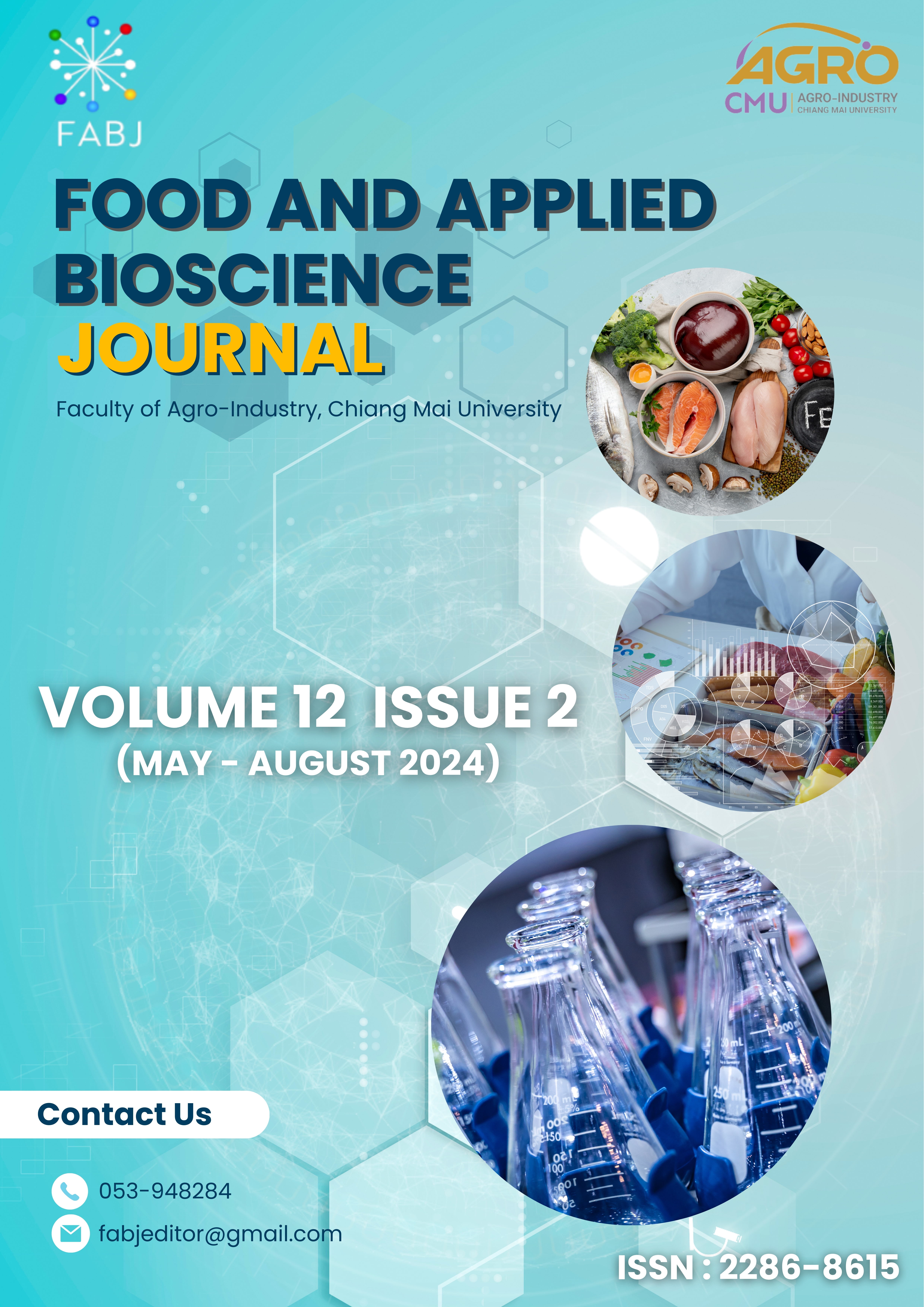The Extraction conditions for bioactive compounds from germinated Black Jasmine rice using aqueous two-phase system
Keywords:
Aqueous two-phase system, gamma-aminobutyric acid, Phenolics compounds, Flavonoid, Antioxidant activityAbstract
Black Jasmine rice is rich in bioactive compounds such as anthocyanins, phenolics, and flavonoids. It can be germinated to gain more bioactive compounds especially gamma-aminobutyric acid (GABA). Generally, bioactive substances can be extracted using several methods, and the aqueous two-phase system (ATPS) is one of the most environmentally friendly extraction methods. Therefore, this work focused on studying the conditions for extracting bioactive compounds from germinated black jasmine rice using the ATPS by studying ethanol concentrations of 32%, 34%, 36%, 38%, 40%, 42%, and 44%, and the sample-to-solvent ratio of 1:50, 1:40, 1:30, 1:20, and 1:10 using ammonium sulfate at 16%. The results showed that an ethanol concentration of 34% and a sample-to-solvent ratio of 1:40 were optimal for extracting a high amount of GABA. Ammonium sulfate concentration of 14%, 16%, 18%, 20%, and 22% were subsequently studied, using an ethanol concentration of 34% and a sample-to-solvent ratio of 1:40., It was found that GABA, phenolics, flavonoids, and Fe2+ chelating activity decreased as the concentration of ammonium sulfate increased., However, the amount of anthocyanin increased with the concentration of ammonium sulfate. This indicated that ATPS can be an alternative environmentally friendly extraction method for bioactive compounds from germinated rice.
References
Dinis, T. C., Madeira, V. M. and Almeida, L. M. 1994. Action of phenolic derivatives (acetaminophen, salicylate, and 5-aminosalicylate) as inhibitors of membrane lipid peroxidation and as peroxyl radical scavengers. Archives of Biochemistry and Biophysics. 315(1): 161–169. https://doi.org/10.1006/abbi.1994.1485.
Eamarjharn, A., Theerakulkait, C. and Thanachasai, S. 2016. Effect of incubation time, buffer type and concentration on gamma-aminobutyric acid (GABA) production using Khao Dawk Mali 105 rice bran. Agriculture and Natural Resources. 50: 80-84. http://dx.doi.org/10.1016/j.anres.2015.04.001.
Fu, X. Q., Ma, N., Sun, W. P. and Dang, Y. Y. 2018. Microwave and enzyme
co-assisted aqueous two-phase extraction of polyphenol and lutein from marigold (Tagetes erecta L.) flower. Industrial Crops and Products. 123: 296–302. https://doi.org/10.1016/j. indcrop.2018.06.087.
Odabas,H. I. and Koca, I. 2021. Simultaneous separation and preliminary purification of anthocyanins from Rosa pimpinellifolia L. fruits by microwave assisted aqueous two-phase extraction. Food and Bioproducts Processing.
: 170–180. https://doi.org/10.1016/j.fbp.2020.11.007.
Is¸çimen,E.M. and Hayta, M. 2021. Microwave-assisted aqueous two-phase system based extraction of phenolics from pulses: Antioxidant properties, characterization and encapsulation. Industrial Crops & Products. 173: 114144. https://doi.org/10.1016/j.indcrop.2021.114144.
Jalali-Jivan, M. and Abbasi, S. 2020. Novel approach for lutein extraction: Food grade microemulsion containing soy lecithin & sunflower oil. Innovative Food Science and Emerging Technologies. 66: 102505. https://doi.org/10.1016/j.ifset.2020.102505.
Lasunon, P., Phonkerd, N., Tettawong, P. and Sengkhamparn, N. 2022.
Total phenolic compound and its antioxidant activity of by-product from pineapple. Food Research. 6(4): 107-112. https://doi.org/10.26656/fr.2017.6(4).453.
Liu, X., Mu, T., Sun, H., Zhang, M. and Chen, J. 2013. Optimization of aqueous two-phase extraction of anthocyanins from purple sweet potatoes by response surface methodology. Food Chemistry. 141(3): 3034–304. https://doi.org/10.1016/j.foodchem.2013.05.119.
Ma, F. Y., Gu, C. B., Li, C. Y., Luo, M., Wang, W., Zu, Y. G., Li, J. and Fu, Y. J. 2013. Microwave-assisted aqueous two-phase extraction of isoflavonoids from Dalbergia odorifera T. Chen leaves. Separation and Purification Technology. 115: 136–144. http://doi.org/10.1016/j.seppur. 2013.05.003.
Peanparkdee, M., Patrawart, J. and Iwamoto, S. 2019. Effect of extraction conditions on phenolic content, anthocyanin content and antioxidant activity of bran extracts from Thai rice cultivars. Journal of cereal science. 86: 86–91. https://doi.org/10.1016/j.jcs.2019.01.011.
Ranganna, S. 1977. Manual of analysis of fruit and vegetable Products. New Delhi, India: Tata-McGraw-Hill Publishing Company Ltd.
Songsamoe,S., Khunjan,K. and Matan,N. 2021. The application and mechanism of action of Michelia alba oil vapour in GABA enhancement and microbial growth control of germinated brown rice. Food Control. 130(3): 108401. https://doi.org/10.1016/j.foodcont.2021.108401.
Sreerama, Y. N., Sashikala, V. B. and Pratape, V. M. 2010. Variability in the distribution of phenolic compounds in milled fractions of chickpea and horse gram: evaluation of their antioxidant properties. Journal of Agricultural and Food Chemistry. 58(14): 8322–8330. https://doi.org/10.1021/jf101335.
Sreerama, Y. N., Sashikala, V. B. and Pratape, V. M. 2012. Phenolic compounds in cowpea and horse gram flours in comparison to chickpea flour: evaluation of their antioxidant and enzyme inhibitory properties associated with hyperglycemia and hypertension. Food Chemistry. 133(1): 156–162. https://doi.org/10.1016/j.foodchem.2012.01.011.
Thai FDA, 2005. Notification of Ministry of Public Health No. (293) B.E.2548 (2005) Re. Food Supplement.
Wang, Y., Han, J., Xu, X., Hu, S. and Yan, Y. 2010. Partition behavior and partition mechanism of antibiotics in ethanol/2-propanol–ammonium sulfate aqueous two-phase systems. Separation and Purification Technology. 75(3): 352–357. https://doi.org/10.1016/j.seppur.2010.09.004.
Xi, J., Zhou, X., Wang, Yu. and Wei, S. 2023. Short-chain alcohol/salt-based aqueous two-phase system as a novel solvent for extraction of plant active ingredients: A review. Trends in Food Science and Technology. 138: 74-84. https://doi.org/10.1016/j.tifs.2023.06.001.
Xu, G., Hao, C., Tian, S., Gao, F., Sun, W. and Sun, R. 2017. A method for the preparation of curcumin by ultrasonic-assisted ammonium sulfate/ethanol aqueous two-phase extraction. Journal of Chromatography B. 1041–1042. 167–174. https://doi.org/10.1016/j.jchromb.2016.12.029.
Downloads
Published
How to Cite
Issue
Section
License
Copyright (c) 2024 Food and Applied Bioscience Journal

This work is licensed under a Creative Commons Attribution-NonCommercial-NoDerivatives 4.0 International License.






